- Joined
- Feb 2, 2011
- Messages
- 2,093
NEW RELEASES FOR JUNE 2023
THE CONQUEST OF AMERICA
THE POWHATAN
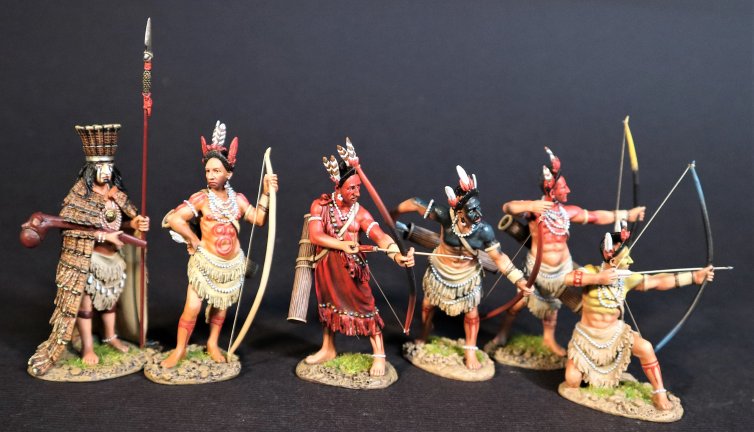
The Powhatan people may refer to any of the indigenous Algonquian people that are traditionally from eastern Virginia. It is estimated that there were about 14,000-21,000 Powhatan people in eastern Virginia, when English colonists established Jamestown in 1607.
In the late 16[SUP]th[/SUP] and early 17[SUP]th[/SUP] centuries, a “Mamanatowick” (paramount chief) named Wahunsenacawh created an organization by affiliating 30 tributary peoples, whose territory was much of eastern Virginia.
They called this area Tsenacommacah (“densely inhabited land”).
Wahunsenacawh came to be known by English colonists as “The Powhatan Chief”.
Each of the tribes within this organization had its own Weroance (leader), but all paid tribute to the Powhatan Chief.
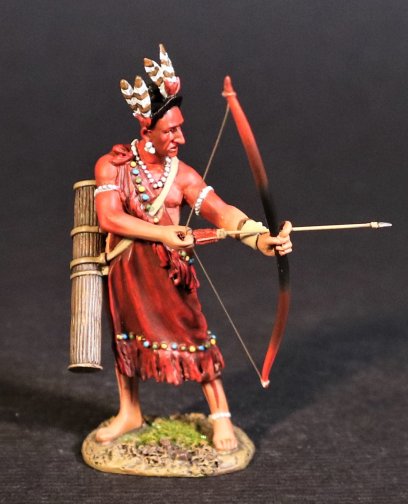
POW-06
THE CONQUEST OF AMERICA,
THE POWHATAN
POWHATAN WARRIOR.
(1 pc)
After Wahunsenacawh’s death in 1618, hostilities with colonists escalated under the chiefdom of his brother, Opchanacanough, who sought in vain to expel encroaching English colonists.
His large scale attacks in 1622 and 1644 met strong reprisals by the colonists, resulting in near elimination of the tribe.
By 1646, what is called the Powhattan Paramount Chiefdom by modern historians had been decimated.
More important than the ongoing conflicts with the English colonial settlements was the high rate of deaths the Powhattan suffered due to new infectious diseases carried to North America by Europeans, such as measles and smallpox.
The native Americans did not have any immunity to these, which had been endemic in Europe and Asia for centuries. The wholesale deaths greatly weakened and hollowed out the native American societies.
By the mid-17[SUP]th[/SUP] century, the leaders of the colony were desperate for labor to develop the land. Almost half of the European immigrants to Virginia arrived as indentured servants.
As settlements continued, the colonists imported growing numbers of enslaved Africans for labour.
By 1700 the colonies had about 6,000 black slaves, which was one-twelfth of the population.
After Bacon’s Rebellion in 1676, the colony enslaved the native Americans for control. In 1691, the House of Burgesses abolished native slavery, however many Powhatan were held in servitude well into the 18[SUP]th[/SUP] Century.
There are several detailed accounts of the Powhatan peoples, but we are fortunate to have the exquisite water-colours of John White, who was the governor of the second Roanoke Settlement.
Luck would have it he was gathering supplies in England when his colony vanished.
The main weapon of all the Indians faced by the English settlers during this period was the longbow. This measured 5-6ft. and was made from witch-hazel or hickory.
It was noted that the Indian bows were quick, but not very strong or accurate.
THE JAMESTOWN SETTLEMENT
THE ANGLO-POWHATAN WARS
Spain, Portugal, and France moved quickly to establish a presence in the New World. The English did not attempt to establish colonies until many decades after their explorations of John Cabot, with early efforts proving to be failiures, most notably the Roanoke Colony which vanished around 1590.
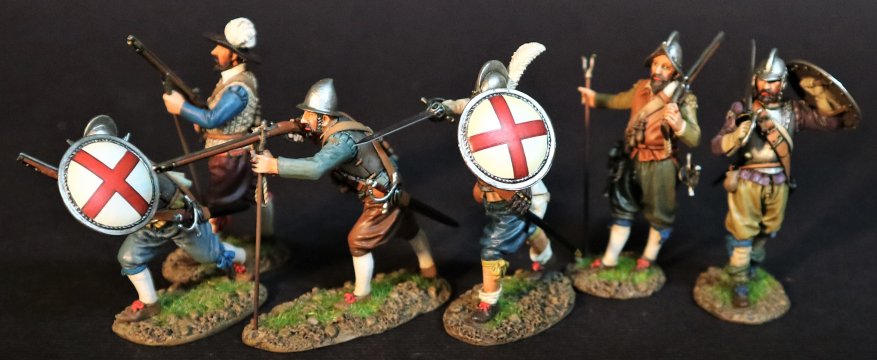
The Jamestown settlement in the colony of Virginia was the first permanent English settlement in the Americas. It was located on the northwest bank of the James (powhatan) river, about 2 ½ miles southwest of the centre of modern Williamsburg.
It was established by the Virginia Company of London, as James Fort on May 4[SUP]th[/SUP] 1607.
The Anglo-Powhatan Wars were three conflicts fought between settlers of the Virginia Colony and Algonquin Indians of the Powhatan Confederacy in the early seventeenth Century.
The first war started in 1609 and ended in a peace settlement in 1614.
After several years of strained co-existence, Chief Opechancanough and his Powhatan Confederacy attempted to eliminate the English colony. This was the start of the second war which was to last from 1622 to 1626.
On the morning of March 22, 1622, the confederacy attacked outlying plantations and communities along the James River in what became known as the Indian Massacre of 1622.
More than 300 settlers were killed in the attack, which was about a third of the colony’s English speaking population.
Jamestown was spared only through a timely warning by a Virginia Indian employee.
Powhatan war practice was to wait and see what would happen after inflicting such a blow, in hopes that the settlement would simply abandon their homeland and move on elsewhere.
However, English military doctrine called for a strong response, and the colonial militia marched out nearly every summer for the next 10 years and made assaults on Powhatan settlements.
Opechancanough was to sue for peace in 1623.
The war lasted until Samuel Argall captured Wahunsenacawh’s daughter Matoaka, better known by her nickname Pocahontas, after which the chief accepted a treaty of peace.
The third war lasted from 1644 until 1646 and ended when Opechancanough was captured and killed. The war resulted in a defined boundary between the Indians and colonial lands that could only be crossed for official business with a special pass.
This situation lasted until 1677 and the Treaty of Middle Plantation which established Indian Reservations following Bacon’s Rebellion.
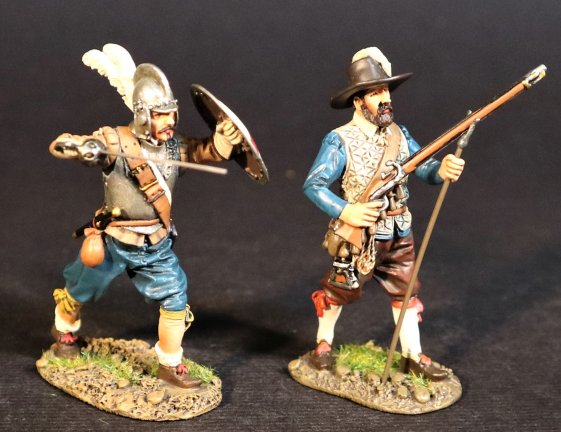
JT-06
THE CONQUEST OF AMERICA,
THE JAMESTOWN SETTLEMENT,
THE ANGLO-POWHATAN WARS
VIRGINIA MILITIA.
(2 pcs)
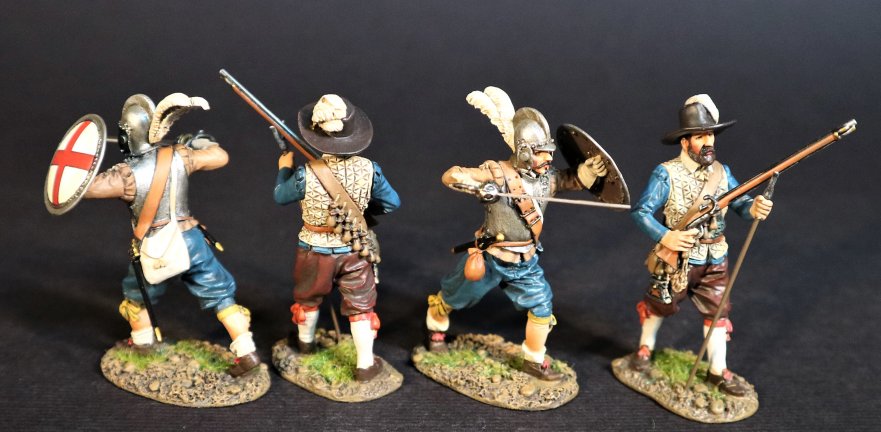
JT-06N
THE CONQUEST OF AMERICA,
THE JAMESTOWN SETTLEMENT,
THE ANGLO-POWHATAN WARS
4 VIRGINIA MILITIA.
(4 pcs)
** PLEASE CONTACT YOUR LOCAL DEALER FOR FURTHER INFORMATION **
THE CONQUEST OF AMERICA
THE POWHATAN

The Powhatan people may refer to any of the indigenous Algonquian people that are traditionally from eastern Virginia. It is estimated that there were about 14,000-21,000 Powhatan people in eastern Virginia, when English colonists established Jamestown in 1607.
In the late 16[SUP]th[/SUP] and early 17[SUP]th[/SUP] centuries, a “Mamanatowick” (paramount chief) named Wahunsenacawh created an organization by affiliating 30 tributary peoples, whose territory was much of eastern Virginia.
They called this area Tsenacommacah (“densely inhabited land”).
Wahunsenacawh came to be known by English colonists as “The Powhatan Chief”.
Each of the tribes within this organization had its own Weroance (leader), but all paid tribute to the Powhatan Chief.

POW-06
THE CONQUEST OF AMERICA,
THE POWHATAN
POWHATAN WARRIOR.
(1 pc)
After Wahunsenacawh’s death in 1618, hostilities with colonists escalated under the chiefdom of his brother, Opchanacanough, who sought in vain to expel encroaching English colonists.
His large scale attacks in 1622 and 1644 met strong reprisals by the colonists, resulting in near elimination of the tribe.
By 1646, what is called the Powhattan Paramount Chiefdom by modern historians had been decimated.
More important than the ongoing conflicts with the English colonial settlements was the high rate of deaths the Powhattan suffered due to new infectious diseases carried to North America by Europeans, such as measles and smallpox.
The native Americans did not have any immunity to these, which had been endemic in Europe and Asia for centuries. The wholesale deaths greatly weakened and hollowed out the native American societies.
By the mid-17[SUP]th[/SUP] century, the leaders of the colony were desperate for labor to develop the land. Almost half of the European immigrants to Virginia arrived as indentured servants.
As settlements continued, the colonists imported growing numbers of enslaved Africans for labour.
By 1700 the colonies had about 6,000 black slaves, which was one-twelfth of the population.
After Bacon’s Rebellion in 1676, the colony enslaved the native Americans for control. In 1691, the House of Burgesses abolished native slavery, however many Powhatan were held in servitude well into the 18[SUP]th[/SUP] Century.
There are several detailed accounts of the Powhatan peoples, but we are fortunate to have the exquisite water-colours of John White, who was the governor of the second Roanoke Settlement.
Luck would have it he was gathering supplies in England when his colony vanished.
The main weapon of all the Indians faced by the English settlers during this period was the longbow. This measured 5-6ft. and was made from witch-hazel or hickory.
It was noted that the Indian bows were quick, but not very strong or accurate.
THE JAMESTOWN SETTLEMENT
THE ANGLO-POWHATAN WARS
Spain, Portugal, and France moved quickly to establish a presence in the New World. The English did not attempt to establish colonies until many decades after their explorations of John Cabot, with early efforts proving to be failiures, most notably the Roanoke Colony which vanished around 1590.

The Jamestown settlement in the colony of Virginia was the first permanent English settlement in the Americas. It was located on the northwest bank of the James (powhatan) river, about 2 ½ miles southwest of the centre of modern Williamsburg.
It was established by the Virginia Company of London, as James Fort on May 4[SUP]th[/SUP] 1607.
The Anglo-Powhatan Wars were three conflicts fought between settlers of the Virginia Colony and Algonquin Indians of the Powhatan Confederacy in the early seventeenth Century.
The first war started in 1609 and ended in a peace settlement in 1614.
After several years of strained co-existence, Chief Opechancanough and his Powhatan Confederacy attempted to eliminate the English colony. This was the start of the second war which was to last from 1622 to 1626.
On the morning of March 22, 1622, the confederacy attacked outlying plantations and communities along the James River in what became known as the Indian Massacre of 1622.
More than 300 settlers were killed in the attack, which was about a third of the colony’s English speaking population.
Jamestown was spared only through a timely warning by a Virginia Indian employee.
Powhatan war practice was to wait and see what would happen after inflicting such a blow, in hopes that the settlement would simply abandon their homeland and move on elsewhere.
However, English military doctrine called for a strong response, and the colonial militia marched out nearly every summer for the next 10 years and made assaults on Powhatan settlements.
Opechancanough was to sue for peace in 1623.
The war lasted until Samuel Argall captured Wahunsenacawh’s daughter Matoaka, better known by her nickname Pocahontas, after which the chief accepted a treaty of peace.
The third war lasted from 1644 until 1646 and ended when Opechancanough was captured and killed. The war resulted in a defined boundary between the Indians and colonial lands that could only be crossed for official business with a special pass.
This situation lasted until 1677 and the Treaty of Middle Plantation which established Indian Reservations following Bacon’s Rebellion.

JT-06
THE CONQUEST OF AMERICA,
THE JAMESTOWN SETTLEMENT,
THE ANGLO-POWHATAN WARS
VIRGINIA MILITIA.
(2 pcs)

JT-06N
THE CONQUEST OF AMERICA,
THE JAMESTOWN SETTLEMENT,
THE ANGLO-POWHATAN WARS
4 VIRGINIA MILITIA.
(4 pcs)
** PLEASE CONTACT YOUR LOCAL DEALER FOR FURTHER INFORMATION **

